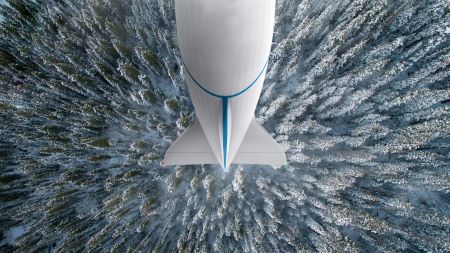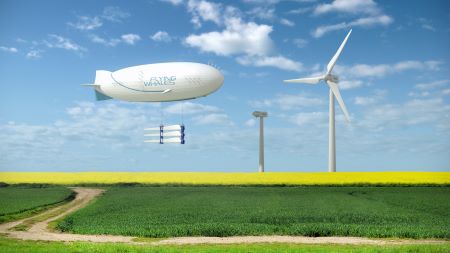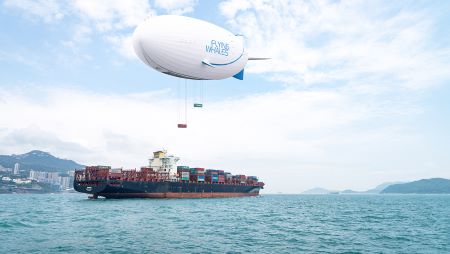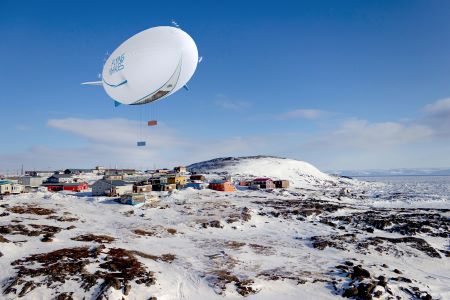Montreal firm is making headway on building giant airships to serve northern Canada
 Buoyed by a $77-million Quebec government investment, a Montreal company is making progress on building giant airships for transporting cargo – including to remote northern Canadian communities and mining sites.
Buoyed by a $77-million Quebec government investment, a Montreal company is making progress on building giant airships for transporting cargo – including to remote northern Canadian communities and mining sites.
Flying Whales Quebéc Inc. has grown to a staff of nearly 30 over the past year and has partnered with several aerospace firms to deliver various components of the lighter-than-air aircraft, said company CEO Arnaud Thioulouse (photo below).
“We have a team to develop part of the airship here, working with our aerospace industrial [partners] in Canada. Today we have more than 40 MOUs with our future customers,” he told Research Money.

Flying Whales Quebéc plans to open a factory in Quebec – the company is still narrowing down a site – to manufacture the airships, with the goal of building its first airship starting in 2027, Thioulouse said.
The Quebec company is a subsidiary of Flying Whales based in Suresnes, in the western suburbs of Paris.
About 200 people at the parent firm are engaged in computerized design, digital modelling and simulation, and engineering for Flying Whales’ first airship, which will be built in Laruscade, Gironde in southwest France starting in 2025, Thioulouse said. Once that first airship is built, tested and receives flight certification – planned for 2027 – Flying Whales Quebéc will start building its first airship in Quebec.
The Quebec government invested 15 million Euros (Cdn$22 million) in France-based Flying Whales in 2019. In the summer of 2022, Quebec, through Investissement Québec, invested 40 million Euros (Cdn$55 million) in the Flying Whales Group. Of this, 25 million Euros went into the share capital of the French company, which translates into Quebec owning 25 per cent of the firm. The remainder of the provincial government's investment went to create Flying Whales Quebéc in the province.
Last year, the Flying Whales group concluded a third round of financing worth 122 million Euros (about Cdn$163 million). Besides Quebec, the round included France’s government – through French Tech Souveraineté – and the Principality of Monaco. Two current shareholders also joined the round – ALIAD (Paris-based Air Liquide’s venture capital arm) and Groupe ADP headquartered in Paris.
Thioulouse said Flying Whales Quebéc has partnered with Honeywell Aerospace in Ontario and, in Quebec with Pratt & Whitney Canada, Thales Canada, and Delastek to produce components for the airship.
Honeywell Aerospace is supplying its one-megawatt turbine generator to supply power for the airship. Each airship will be able to carry four generators, supplying enough power for all the airship’s electricity needs as well as its propeller-driven propulsion system, Thioulouse said.
Thales Canada is developing the airship’s avionics, or flight control systems. Delastek, a company in Shawinigan, Quebec, is designing the cockpit components for the airship’s gondola where a two-person crew will operate the craft.
Flying Whales in France also has signed a strategic partnership with the State of Victoria, Australia, to build what will become the company’s third airship manufacturing factory, including the facilities in France and Quebec.
Thioulouse said the plan is to build airships in France to serve the European and African markets, in Quebec to serve North American and South America, and Australia for the Asia-Pacific market.
Flying Whales’ business plan is based on the forecast need for 160 airships – built across the company’s three manufacturing plants – during the first 10 years the craft are operating, Thioulouse said.
Interest in airships growing in Canada’s North
Each of Flying Whales’ LCA60T airships is 200 metres long – larger than two Airbus A380 airframes – with cargo space 96 metres long by seven metres wide and eight metres high. One airship could transport the equivalent of about 40 standard-sized industrial containers for transporting goods. So each airship could carry oversized loads of up to 60 tonnes.
 Thioulouse noted that the company’s airship would be able to transport wind turbines, which are so long they’re very difficult to move by tractor-trailers on roads – providing roads are available.
Thioulouse noted that the company’s airship would be able to transport wind turbines, which are so long they’re very difficult to move by tractor-trailers on roads – providing roads are available.
Based on current design plans, the airship will remain in the air without landing at a base. A sling inside the airship’s cargo hold would be used for in-flight loading and unloading of cargo, which eliminates the need for ground-based infrastructure – a cost savings for remote communities and developing countries.
Flying Whales will build a rigid airship with a composite main frame and a textile envelope surrounding the frame. The airship’s lift will be supplied by non-pressurized cells filled with helium gas. The airship will be capable of flying up to 100 kilometres per hour in “cruise” mode, at a maximum altitude of 3,000 metres.
Thioulouse said the airship could do very long missions by carrying two crews – each crew with one pilot and one payload master responsible for the cargo. The craft’s gondola includes a rest area for crews.
Flying Whales has calculated how much each airship will cost to build; however, this information is proprietary. The company has so far raised 162 million Euros (Cdn$235 million) from both public and private investors.
 Flying Whales Quebéc is working with different industrial sectors in Canada on applications for its airships, Thioulouse said. In addition to transporting goods to remote communities in the North, isolated mining companies – including new mines for critical minerals needed for Canada’s energy transition – could use the airships. The craft also could deliver a well-equipped mobile hospital, food, water and other aid after natural disasters.
Flying Whales Quebéc is working with different industrial sectors in Canada on applications for its airships, Thioulouse said. In addition to transporting goods to remote communities in the North, isolated mining companies – including new mines for critical minerals needed for Canada’s energy transition – could use the airships. The craft also could deliver a well-equipped mobile hospital, food, water and other aid after natural disasters.
The Quebec company has signed an MOU with the Inuit-owned Canadian North airline, which serves Nunavut, Northwest Territories and the Nunavik region of Quebec. “We will be able to provide them with a new way of transportation that will be complementary to what they do now,” Thioulouse said.
Transporting goods, from perishable foods to building materials to office supplies, to Canada’s North by tractor-trailers, fixed-wing aircraft or ships is very expensive, and depends on the size and location of each community and seasonal weather changes including ice buildup. There are hundreds of remote communities in the North, including many that rely on winter roads, or “ice roads,” to bring in goods.
 “We’re seeing the shortening of those [ice road] seasons, both at the front end and at the back end, and the loss of trucks on those rivers or lakes, or the impassibility on roads that are just in atrocious conditions,” said Madeleine Redfern (photo at left), an Indigenous businesswoman, chief operating officer of CanArctic Inuit Networks, and former mayor of Iqaluit in Nunavut.
“We’re seeing the shortening of those [ice road] seasons, both at the front end and at the back end, and the loss of trucks on those rivers or lakes, or the impassibility on roads that are just in atrocious conditions,” said Madeleine Redfern (photo at left), an Indigenous businesswoman, chief operating officer of CanArctic Inuit Networks, and former mayor of Iqaluit in Nunavut.
As for transport by ship, it’s very difficult for smaller communities to schedule a shipment on a ship that comes once a year and where cargo space is limited and there’s a lineup of orders, she said in a video from the “Climate Change and Northern Transport” webinar in 2022.
“We fly up so much of our food it absolutely contributes to the high cost of food,” which results in food insecurity among Northern residents, including eight out of 10 Inuit pre-school children who are food insecure, Redfern said.
Airships would eliminate Northern communities dependence on ice roads
 A big benefit of airships would be eliminating Northern communities’ dependence on ice roads, says Dr. Barry Prentice (photo below), PhD, professor, supply chain management at the University of Manitoba and director of the University of Manitoba’s Transport Institute.
A big benefit of airships would be eliminating Northern communities’ dependence on ice roads, says Dr. Barry Prentice (photo below), PhD, professor, supply chain management at the University of Manitoba and director of the University of Manitoba’s Transport Institute.
For more than two decades, he has been advocating for the building and use of airships in Canada. He created ISO Polar Airships, a not-for-profit organization, in 2005 to promote the use of airships as sustainable transport for northern latitudes.
 Prentice testified a decade ago to the House of Commons Standing Committee on Transport, Infrastructure and Communities. In its 2013 report, “Innovative Transportation Technologies,” the committee recommended the federal government should consider a “pilot project” involving airship transport of non-urgent goods to remote destinations. After airships are proven reliable, the government should “allow them to compete on a level playing field with other modes of transportation for federal government contracts delivering heavy cargo over long distances,” the committee said.
Prentice testified a decade ago to the House of Commons Standing Committee on Transport, Infrastructure and Communities. In its 2013 report, “Innovative Transportation Technologies,” the committee recommended the federal government should consider a “pilot project” involving airship transport of non-urgent goods to remote destinations. After airships are proven reliable, the government should “allow them to compete on a level playing field with other modes of transportation for federal government contracts delivering heavy cargo over long distances,” the committee said.
The season for ice roads, which require at least one metre of ice on lakes and rivers to support a tractor-trailer, is getting shorter because the North is warming faster than the global average due to climate change, Prentice told Research Money. “I don’t think the ice roads will be available within five years, if this planet change continues.”
Even existing gravel and asphalt roads in the North are being damaged as the permafrost they’re built on keeps melting, he added.
Replacing temporary ice roads with permanent gravel roads would cost between $3 million to $5 million per kilometre – a prohibitive expense for cash-strapped federal and provincial governments.
Prentice is also a founder and president of Winnipeg-based Buoyant Aircraft Systems International (BASI), an airship company created 13 years ago. BASI has built and tested prototype airships as well as its Buoyant Aircraft Rotating Terminal. It is essentially a rotating turntable on which an airship could land, be securely anchored and controlled on the ground – enabling cargo to be safely loaded and off-loaded.
It would require 18, 30-tonne-lift airships to service remote communities in Canada’s North, according to a 2023 study, “Cargo Airship Strategy for Northern Canada,” by the Canadian Arctic Innovation Association. The potential demand by the mining sector also is huge. One proposed rare earths mine, Torngat in northern Quebec, would alone require six airships.
Canada requires a hub to test airships for flight certification. Prentice said that Thompson, Manitoba, which is already known for winter-testing of vehicles, would be ideal because the community has some worked-out, open-pit, trench-shaped mines where the airships could land and shelter.
Prentice recently got a letter of support for Thompson becoming a winter-testing location for airships from the grand chief of the Keewatin Tribal Council, which represents 11 communities spread throughout northern Manitoba and whose office is in Thompson.
In his letter, the chief noted that for a building project in one of the tribal council’s communities, they needed to bring in $250,000 worth of building materials. But the load missed the ice road season, and the cost of transportation ended up being more than $500,000 – on top of the $250,000 for the materials.
Airships are competitive in freight costs with truck transport
The Canadian Arctic Innovation Association’s study found that freight rates for transporting 30 tonnes of goods to Thompson using an airship “are actually the equivalent of or a little bit less than the costs of moving things in by tractor-trailer over ice roads,” Prentice said.
Also, with ice roads, the latest time that building materials can arrive in remote communities is the middle of March, when ice roads can no longer be used. However, it’s still winter so no construction can start.
“So the materials are covered with a tarp and shoved in a snowbank. By the time they come around to start building, a lot of these materials are damaged from mold and being exposed to winter temperatures, Prentice said. “The airships can bring things in on a just-in-time basis, so you don’t have to store them for long periods.”
Some Northern communities have unemployment rates of 80 per cent. Prentice said one reason is that local residents aren’t able to accumulate enough hours of work to become certified as professional carpenters, plumbers and other trades. But an extended construction period enabled by airship transport would make it possible for people to get the hours needed for trade certification, he said.
To support building airships in Canada, the federal government should issue a policy statement through Transport Canada that the country needs and wants an airship program, Prentice said. “The lack of clarity on the government’s part creates uncertainty that makes it difficult to attract private investment.”
Government also has an important role in providing the common-use infrastructure and ground-handling locations required for airships, he said.
“We do not need a government-owned airship company, but they do need to subsidize this, just like they are subsidizing the Volkswagen battery plant or any other new venture,” Prentice said. “More importantly, the North is their responsibility and we are already spending taxpayer money like it was water without any improvement. Airships would bring a transformational change that would build the economy and reduce the drain on the treasury.”
The federal government’s Nutrition North spends more than $130 million per year and rising on subsidizing the cost of transporting food to the North, Prentice noted.
He estimates that establishing a complete airship program, including having an airship certified to work in the North, would cost approximately $1 billion. In comparison, federal and provincial government subsidies for three foreign companies building EV batteries in Canada amount to more than $32 billion.
“Once the airships are there, people will pay for them themselves. We’re not just consuming $1 billion in transport subsidies,” he said.
Prentice also argues that the use of hydrogen as a lifting gas in airships – which Canadian regulations now prohibit – should be allowed. It is illogical for hydrogen in a pressurized tank to be allowed in fixed wing aircraft and in vehicles including transit buses, but not hydrogen in a non-pressurized container in airships, he said. “Regulations must catch up to science.”
Ventilation is the key to employing hydrogen safely in airships and can be easily done in rigid airships, including by using inexpensive sensors that can detect the smallest leaks, he said.
“It was not the Hindenburg accident [in 1937] that ended the use of airships,” Prentice said. “It was the jet engine. The ability to travel five times faster, and in what was perceived to be greater safety, made jet airliners very desirable.”
There is no longer any technical challenges to building airships, Prentice wrote in a 2012 report co-authored by Ron Hoschstetler, a senior systems engineer, which argued for establishing an “X-prize competition” to encourage airship development. “The [main challenge] today is the lack of business confidence and policy direction to support investment in a technology that outmoded thinking holds as being dangerous and uneconomic.”
Click here to see a video on YouTube about the Flying Whales project.
Click here to see a short video on the various components of Flying Whales' airship.
Click here for videos of various speakers at the Airships to the Arctic 2023 webinar.
All images of airships courtesy of Flying Whales.
R$
Events For Leaders in
Science, Tech, Innovation, and Policy
Discuss and learn from those in the know at our virtual and in-person events.
See Upcoming Events
You have 0 free articles remaining.
Don't miss out - start your free trial today.
Start your FREE trial Already a member? Log in
By using this website, you agree to our use of cookies. We use cookies to provide you with a great experience and to help our website run effectively in accordance with our Privacy Policy and Terms of Service.


.png)

.png)